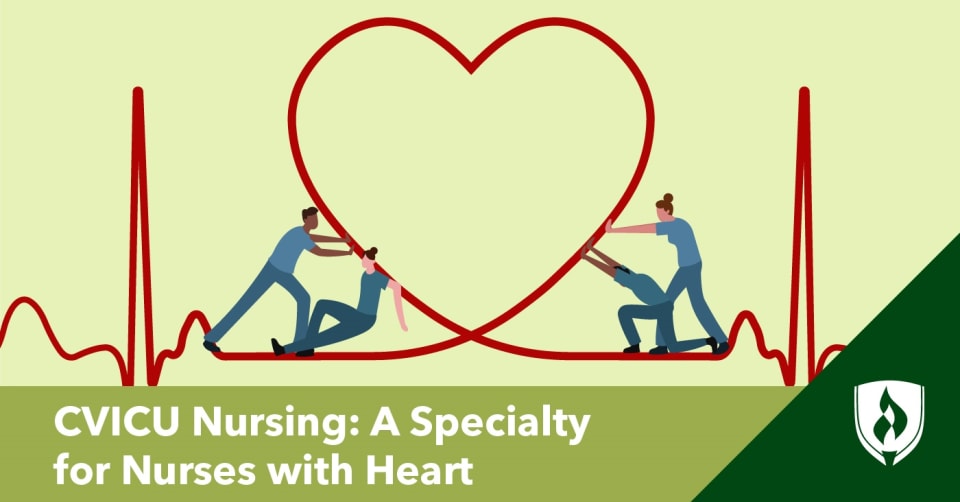
You might not know it, but in the healthcare community, cardiovascular intensive care unit (CVICU) nurses are often stereotyped as highly knowledgeable and intensely detail-oriented when it comes to patient care. While no stereotype is entirely true, CVICU nurses know their stuff for a reason: their patients are often extremely sick. Dealing with the challenges patients face with heart disease—what the Centers for Disease Control identifies as the leading cause of death for both men and women—requires both compassion and expertise.1
The CVICU can be an intense place, and while it isn’t the right workplace for every nurse, it might be for you. Keep reading to get a deeper understanding of CVICU nursing and hear firsthand insights from CVICU nurses in the field.
What is the CVICU?
Staff in the CVICU, sometimes called the CTICU (cardiovascular thoracic ICU), care for critically ill patients with cardiac, thoracic and vascular conditions. Many patients may come from the “cath lab” (catheterization laboratory), the operating room after undergoing cardiovascular surgery or from another hospital that can’t provide the level of care the patient needs. The patient may need additional surgery or may just need to recover before being discharged or transferred to another unit. Other patients, like congestive heart failure patients, may require no surgical intervention but need a lot of care and monitoring.
CVICU units generally only exist in large hospitals and sometimes serve as a back-up for the other ICUs when they are full, taking patients that aren’t their typical patient. Since CVICU nurses have a strong understanding of how the heart affects all the organs, they are usually well-equipped to care for patients who are still awaiting diagnosis. Once the patient is diagnosed or a more appropriate bed opens up, the patient may be moved there.
CVICU units are typically fast paced, with cardiovascular patients requiring a lot of care from nurses and nursing aides. “There really is no typical day on a CVICU unit,” says Tina Vinsant, BSN, CCRN, and creator/host of Good Nurse Bad Nurse Podcast. “It’s organized chaos.”
What does a CVICU nurse do?
CVICU nurses assess and provide care for patients dealing with cardiothoracic conditions and diseases. They’re constantly evaluating their patients since the patients are usually extremely sick and can take a bad turn at a moment’s notice. Sean Karbach, BSN, RN, CCRN-CSC, creator/host of the Nurse Dose podcast, thinks that though nurses utilize their assessment skills in every specialty, they might be used even more in the CVICU due to how critical the patients are. “Even just a change in skin temp can clue you into a clinical change,” says Karbach.
CVICU nurses care for patients with heart or lung conditions that need constant and sometimes invasive monitoring. They are constantly keeping their eyes on a variety of patient health indicators like blood pressure, oxygen saturation, heart rate and body temperature. Additionally, many CVICU patients are also observed via hemodynamic monitoring which involves a pulmonary artery catheter in the right side of the heart. This allows for the measurement of central venous pressure (CVP), filling pressure, preload pressure, pulmonary artery pressures and cardiac output.
Working with highly technical medical equipment is a part of the job. CVICU patients also frequently have other lines and devices that the nurse monitors, including—
- Central line: type of IV line that goes into a vein close to the heart
- Ventilator: machine that moves air in and out of the patient’s lungs through an endotracheal tube
- IV: intravenous line in a peripheral vein that allows meds to be pushed directly into the bloodstream and blood to be drawn
- Chest tube drain: tube inserted into the pleural space to remove air or fluid
- Foley catheter: tube placed into the bladder to drain urine
- Extracorporeal membrane oxygenation (ECMO): machine that oxygenates the patient’s blood so their heart and lungs can rest
- Bilevel positive airway pressure (BIPAP): non-invasive type of ventilation that delivers oxygen via mask over the patient’s nose and mouth and changes pressure with inhales and exhales
- Pacemakers: device that helps regulate the heartbeat. Can be internal or external
While CVICU nurses have help for many of them, including respiratory therapists that usually set up the ventilators and BIPAP machines, they still need to have the drive and initiative to learn about these devices.
Vinsant remembers being terrified of external pacemakers when she first started working in the CVICU. She states that many of the settings for these devices operated completely differently from how she first thought they would, and there were large differences between manufacturers. While that was certainly an intimidating learning curve, given how important these devices are, she persevered by partnering with another nurse in her unit to study until they finally felt comfortable with the variety of devices they’d encounter. This is just one example of the deep expertise nurses need to navigate an intensive care role—Vinsant notes that you truly have to understand the “why?” behind an action.
“It’s important to truly know what you’re doing, why you’re doing it and what result you’re looking for,” Vinsant says.
Monitoring patients with heart conditions means having a strong handle on hemodynamics, ECG/EKGs and how the heart affects the rest of the body’s organs. Not only do CVICU nurses have to be well-versed in all these subjects, but they also must be able to explain the patient’s condition in plain language to patients and their families.
Managing all this may seem like a lot—and it is—but it does get easier eventually. “The more experience you gain, the less challenging it is,” says Megan Brunson MSN, RN, CNL, CCRN-CSC, and AACN President 2019–2020.
Characteristics and traits of a strong CVICU nurse
A lot of nurses can perform the functions of working in that kind of environment, but what does it take to thrive? Especially when first starting out, you have to get comfortable with being uncomfortable. The acuity of CVICU patients is high, and there’s always going to be things you don’t know.
“Learn to use your resources and how to ask for help,” says Vinsant.
While CVICU nurses are almost always learning, they also tend to be highly motivated, type-A people who like a little bit of adrenaline—they need to think and act quickly if a patient takes a sudden turn for the worse.
What is rewarding and challenging about CVICU nursing?
The challenge of managing such critical patients is one of the rewarding parts of CVICU nursing, according to Karbach. “The amount of numbers you need to remember and the correlation between those numbers and clinical picture make each patient a complex puzzle that when solved, can hopefully get them out of the ICU,” Karbach says.
Discharging a patient and seeing them walk out of the unit is another rewarding aspect of the job. Though patients do get discharged from most units in a hospital, there is something special about it on such an intensive unit. “Seeing those people, who just days before had their chest cracked open, walk out of the ICU is something magical,” says Karbach.
While seeing such progress is remarkable, caring for the heart-failure patients who are in and out of hospitals is rewarding as well, especially for experienced CVICU nurses who build up long-term relationships with these patients. These tend to be non-surgical patients with balloon pumps that give them a second lease on life. But even with that, all their organs are affected by the heart failure and their medications are a challenge to manage. “New nurses might like surgical patients, but after 20-some years, heart-failure patients are a treasure to me,” says Brunson.
It is challenging, of course, when those patients don’t make it off the unit and pass there. CVICU nurses are used to managing codes and are very familiar with Advanced Cardiac Life Support (ACLS). While it’s rewarding to be there to support those patients and their families in their passing, you don’t forget those moments. “I don’t want to get rid of those memories, but sometimes it gets a little heavy,” says Vinsant.
Working in the CVICU can be cognitively and emotionally intense, which leads some nurses to burn out. Brunson reminds newer CVICU nurses not to let the feelings pile up and to find someone to talk things out with.
How to become a CVICU nurse
The first step on the road to becoming a CVICU nurse is to become a registered nurse (RN). To become an RN, you’ll need a degree—either an Associate’s Degree in Nursing (ADN) or a Bachelor of Science in Nursing (BSN)—and meet all other requirements for state licensure. Once licensed, you’ll be qualified to apply to a variety of nursing positions.
When choosing your degree path, you should keep in mind that a BSN may be beneficial when going into critical care. Though ADN nurses complete just as many clinical hours as BSN nurses, BSN nursing students do additional coursework in leadership, understanding research and practice critical thinking on another level which can be especially beneficial in ICU settings.
“It’s going to be much harder in the next 5–10 years to be in an ICU with an ADN,” says Brunson.
Though it is possible to get a CVICU job right out of nursing school, many nurses do work in other units like a progressive care unit (PCU) or telemetry unit first.
Brunson notes that in her experience, many new grads have struggled starting out immediately in the CVICU as the learning curve can be overwhelming. But after they transitioned to the PCU for a year or two, they were able to come back to the CVICU and find success. “It’s a rare bird who can come out of nursing school and go straight to the CVICU,” says Brunson.
CCRN Certification
Another way you can potentially better your chances of working as a CVICU nurse is to become certified as a Critical Care Registered Nurse (CCRN) through the American Association of Critical Care Nurses (AACN). Though certification generally isn’t required, it is helpful.
“You’re showing a potential manager that you take ownership of your own career and your skills, that you have that initiative and that drive,” says Vinsant. She states that just preparing for certification exams helped her step up her nursing skills.
Certification can also impact your relationship with your coworkers and your patients. “It exemplifies your commitment to your patients, specialty and profession,” says Brunson.
Is CVICU nursing in your future?
CVICU nursing is unique in the acuity of the patients but also the dramatic recovery that CVICU nurses get to witness and the healing they play a big role in. If you’re up for those extremes, the CVICU might be the right fit for you.
If you’re ready to start down your path of becoming a registered nurse, begin with our article “How to Become a Registered Nurse: Your 4-Step Guide.”
Though you certainly don’t have to choose a specialty before becoming an RN, if you’re intrigued by the variety of specialties RNs can work in and want to discover more, check out our article “Top 25 Types of Nurses Employers Are Looking to Hire.” or read more about Vascular Access Nursing.
1“FastStats: Leading Causes of Death” National Center for Health Statistics, Centers for Disease Control and Prevention. October 19, 2021 [accessed January 2022] https://www.cdc.gov/nchs/fastats/leading-causes-of-death.htm




